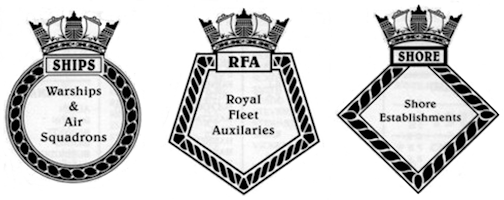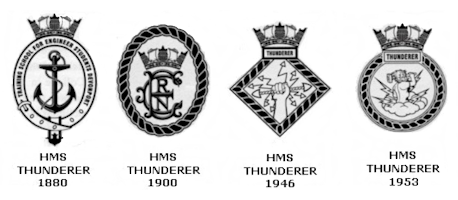|
The THUNDERER name was awarded to the Royal Naval Engineering
College in 1947. The college had been founded at Keyham in 1880, but during the
second war the move to Manadon had begun, with the building of the hangars and
instructional block, and the use of Manadon House as the Officer's Mess with
accommodation in Nissen huts stretching down to the tennis courts.
When
Keyham had been founded in 1880, a badge was adopted showing the naval crown
and foul anchor, surrounded by a garter carrying the original title "Training
School for Engineer Students Devonport". This badge was superseded around 1900
by the interlaced RNEC monogram in a ropework border, which remained in use for
many years.
With the award of the name HMS THUNDERER to the combined
colleges of Keyham and Manadon, the 1919 battleship badge was re-adopted,
showing a hand grasping a thunderbolt and six lightning flashes, with the motto
"Eripimus Jovi Fulmen" meaning "We snatch the thunder from Jove", a classical
reference to the growth of reason replacing superstition, as men began to
understand the science that lay behind natural phenomena.
This new badge
lasted only until 1953, when an old design based on the original battleship's
gun tompions was re-adopted. This showed a wild figure, more like Thor than
Jove, swinging a great hammer, and surrounded by lightning flashes. An English
motto, "Strike the iron while 'tis hot" was adopted; this seems to have some
reference to the process of engineering education.
This new badge was
shown in a circular ropework border, because during the 1950's, the pre-war
conventions had all broken down, as new ships maintained their predecessor's
badges rather than casting new ones. Thus destroyers were using the cruisers'
shield-shaped badges, and frigates were adopting the destroyers' pentagons. The
1947 badge was properly placed in the "lozenge" or diamond-shaped frame
reserved for auxiliaries, (including aircraft-carriers and submarines, which
seemed of small importance when the system was established in 1919). By 1953,
however, the prevailing anarchy meant that ships could adopt any shape of badge
they had inherited, or use a circular frame, (formerly reserved for
battleships) for any new designs that arose. At least THUNDERER had the
justification that the establishment's predecessor had been a battleship,
though the version used in the Manadon wardroom was totally unofficial in
design, even though it was very appropriate in style.
In 1976, a DCI was
published requiring all ships and establishments to conform to a new code, as
follows:
|
Warships & Air Squadrons: |
Circular |
|
Royal Fleet Auxilliaries: |
Pentagonal |
|
Shore Establishments: |
Diamonds |

|

